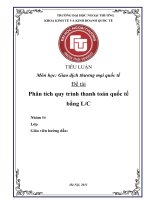Thuyết trình thanh toán quốc tế "Tỷ giá hối đoái USD/VNĐ 2009-2010" doc
Bạn đang xem bản rút gọn của tài liệu. Xem và tải ngay bản đầy đủ của tài liệu tại đây (5.4 MB, 21 trang )
What is the exchange rate?
•
The exchange rate is the rate at which one currency
may be converted into another. The exchange rate is
also the value of one currency in comparison with
another currencies.
•
Eg $ 1 = ¥ 115.19, which prices are expressed in U.S.
dollars and $ 1 price was JPY ¥ 115.19.
•
The exchange rate also means the price of one unit of
foreign currency per domestic currency.
Nominal exchange rate is the price of one unit of foreign
currency per domestic currency and not to mention the
purchasing power of money.
Real exchange rate is the nominal exchange rate was
adjusted according to relative prices between countries.
Effective exchange rate is weighted average of a basket
of foreign currencies.
Equilibrium Real Exchange Rate is the exchange rate at
which the demand for a currency and supply of the same
currency are equal. The equilibrium exchange rate
indicates that the price of exchanging two currencies will
remain stable.
Demand and supply for foreign currency
Interest rate difference between two countries.
Inflation rate difference among countries.
Balance of payments. Besides, Crowd psychology,
government policies, credibility of the currency, etc
… also affect the exchange rate.
Exchange rate situation in
Exchange rate situation in
Vietnam in 2009
Vietnam in 2009
In 2009 years could be considered
"currency year" in Vietnam.
In fact, this was happened since the
beginning of the foreign exchange market
that shows it always stress.
Exchange rate movements
Stage1: Exchange rate fluctuated between 17.450 dong
and 17.700 dong , with the ceiling price ranges from 0 to
200 points (a point equivalent to a dong).
I. The interbank market
January 2009
February 2009
March 2009
March 2009
Exchange rate movements
I. The interbank market
Stage 3 : by the end of October 2009, increasing the
exchange rate, rises 0,11% in comparison with the first of
October 2009 and to November 10 above the ceiling price
of 1000 points. Exchange rate fluctuations is very intense,
a day increased from 200 to 300 points and peaking at
19,750 in November 24
th
. Until the State Bank allowed
back in gold, it fell for two days but still higher than 1200-
1500 points over the ceiling price.
I. The interbank market
The enterprises keep dollars holding, many export enterprises
suppose that need to “foresight”, so not sell the foreign
currency, or sell limited quantities for commercial banks.
Therefore, the lack of needed foreign currency for regulating
the economy happened in banks.
By the first of September, the new USD interest rate was fell
during two months ago by the bank that has trended to rise for
keeping the depositors when the invest channels become more
attractive.
In mid-September, Exchange rate USD/VND was exciting
again, repeatedly set milestones record. Because the
enterprises do not only take advantage of the low interest rate
to borrow, but also increase purchase dollars for import.
Exchange rate movements
Stage 4: the exchange rate declined from a high of 19,800 dong
to 18,500 dong, close to the ceiling price.
I. Interbank market
State bank adjust the amplitude reduction to set rates +3% since
11.26.2009.
SB increased the base rate to 8% per year, the refinancing rate to 8%
per annum and the rediscount rate to 6% per annum since 12/2009.
To apply for the interest rates in VND capital below 10.5%.
Sell foreign currency to support the credit institutions.
Combining the concerned departments to inspect the operation
control of foreign currency trading.
=> Stimulating demand for domestic currency and rising supply for
foreign currency (USD)
Exchange rate movements
II. Free market changes much more intense
Exchange rate movements
Stage 1, it was varried a bit around the price of 16.980 dong.
Stage 2, after loosening amplitude, rates declined from 16,980 dong to
16,935 dong (- 0.26%) and maintained until the end of May 2009. Since
June 2009, although the State Bank adjust to rise gradually, but low growth.
Stage 3, Growth rate of the average exchange rate to the interbank was still
not much and until November 19, 2009 by 0,3% in comparison with in the
end of 2008.
Stage 4, Since Nov 26
th
, SB’s average exchange rate was adjusted to rise to
5,44%, more than in 2008 the increase was only 5,11%.
III. State bank market changes a little
2009
Forecast in 2010
2009 was the year the implementation of the stimulus package,
potentially inflationary.Thus, in 2010 the implementation of
policies to control inflation is entirely possible.
The trade deficit will increase in 2010, due to the restructuring
economy policy of government in rural areas.
Dollar devaluation on the world market caused the demand for
gold increases.
Developed countries focus on economic recovery should be
reduced FDI » Reduce the supply of foreign currency (USD),
etc…
Exchange rate fluctuations will still rise, but slow and
steady. The tight control of borrowing dollars for production
activities will limit speculation in order to increase the virtual
dollar. 2010 will be one year implementation of monetary policy
tightening to ensure stable the development of the economy.









